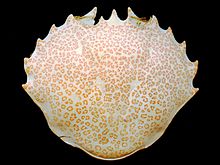- Ovalipes ocellatus
-
Ovalipes ocellatus 
A moulted carapace of O. ocellatus Scientific classification Kingdom: Animalia Phylum: Arthropoda Subphylum: Crustacea Class: Malacostraca Order: Decapoda Infraorder: Brachyura Family: Portunidae Genus: Ovalipes Species: O. ocellatus Binomial name Ovalipes ocellatus
(Herbst, 1799) [1]Synonyms [2] - Cancer ocellatus Herbst, 1799
- Portunus pictus Say, 1817
Ovalipes ocellatus is a species of crab from eastern North America, known as the lady crab, calico crab or ocellated crab.[3] It has a shell 3 in (7.6 cm) long and only slightly wider, which is covered in clusters of purple spots. It occurs from Canada to Georgia, and lives mainly on molluscs, such as the Atlantic surf clam.
Contents
Description
The carapace of O. ocellatus is slightly wider than long, at 8.9 centimetres (3.5 in) wide,[3] and 7.5 cm (3.0 in) long.[4] This distinguishes it from other crabs in the family Portunidae, which often have elongated lateral spines.[4] The carapace is yellow-grey[4] or light purplish,[3] with "leopardlike clusters of purple dots",[4] and 3–5 spines along the edge behind each eye.[3] O. ovalipes is almost identical to O. floridanus, which lives in the Gulf of Mexico, but can be separated from the sympatric O. stephensoni by the purple spots, which O. stephensoni lacks.[4]
Distribution
The distribution of O. ocellatus extends from Canada to Georgia.[4] O. ocellatus is "probably the only Ovalipes species common north of Virginia", being replaced by Ovalipes stephensoni to the south.[5]
Life cycle
O. ocellatus has five larval stages, lasting a total of 18 days at 25 °C (77 °F) and a salinity of 30‰, and 26 days at 20 °C (68 °F) and 30‰.[6]
Ecology
O. ocellatus is a nocturnal[4] predator,[3] which often buries itself in the sand.[3] It has been described as "vicious" and "the crab most likely to pinch a wader's toes".[4] It feeds mostly on molluscs, particularly the Atlantic surf clam Spisula solidissima.[7]
Taxonomic history
O. ocellatus was first described by Johann Friedrich Wilhelm Herbst in 1799, as Cancer ocellatus.[2] In 1898, Mary Jane Rathbun moved the species to her new genus Ovalipes.[8]
References
- ^ "Ovalipes ocellatus (J. F. W. Herbst, 1799)". Integrated Taxonomic Information System. http://www.itis.gov/servlet/SingleRpt/SingleRpt?search_topic=TSN&search_value=98714. Retrieved August 29, 2011.
- ^ a b P. Davie (2010). "Ovalipes ocellatus (Herbst, 1799)". World Register of Marine Species. http://www.marinespecies.org/aphia.php?p=taxdetails&id=158434. Retrieved June 6, 2010.
- ^ a b c d e f Leland W. Pollock (1998). A practical guide to the marine animals of northeastern North America. Rutgers University Press. ISBN 9780813523996.
- ^ a b c d e f g h Eugene H. Kaplan (1999). "Lady crab Ovalipes ocellatus". In Roger Tory Peterson. A Field Guide to Southeastern and Caribbean Seashores: Cape Hatteras to the Gulf Coast, Florida, and the Caribbean. Peterson Field Guides (2nd ed.). Houghton Mifflin Harcourt. pp. 322. ISBN 9780395975169.
- ^ William S. Johnson & Dennis M. Allen (2005). "Swimming (Portunid) crabs". Zooplankton of the Atlantic and Gulf coasts: a guide to their identification and ecology. Johns Hopkins University Press. pp. 220–222. ISBN 9780801880193.
- ^ Stephan Gregory Bullard (2003). "Ovalipes ocellatus (Herbst, 1799)". Larvae of anomuran and brachyuran crabs of North Carolina: a guide to the described larval stages of anomuran (families Porcellanidae, Albuneidae, and Hippidae) and brachyuran crabs of North Carolina, U.S.A.. Volume 1 of Crustaceana monographs. Brill. pp. 29–30. ISBN 9789004128415.
- ^ Linda L. Stehlik (1993). "Diets of the brachyuran crabs Cancer irroratus, C. borealis, and Ovalipes ocellatus in the New York Bight". Journal of Crustacean Biology 13 (4): 723–735. JSTOR 1549103.
- ^ Mary Jane Rathbun (1898). "The Brachyura collected by the U. S. Fish Commission steamer Albatross on the voyage from Norfolk, Virginia, to San Francisco, California, 1887-1888". Proceedings of the United States National Museum 21 (1162): 567–616. http://biostor.org/reference/3351.
Categories:- Portunoidea
- Crustaceans of the Atlantic Ocean
- Animals described in 1799
Wikimedia Foundation. 2010.
